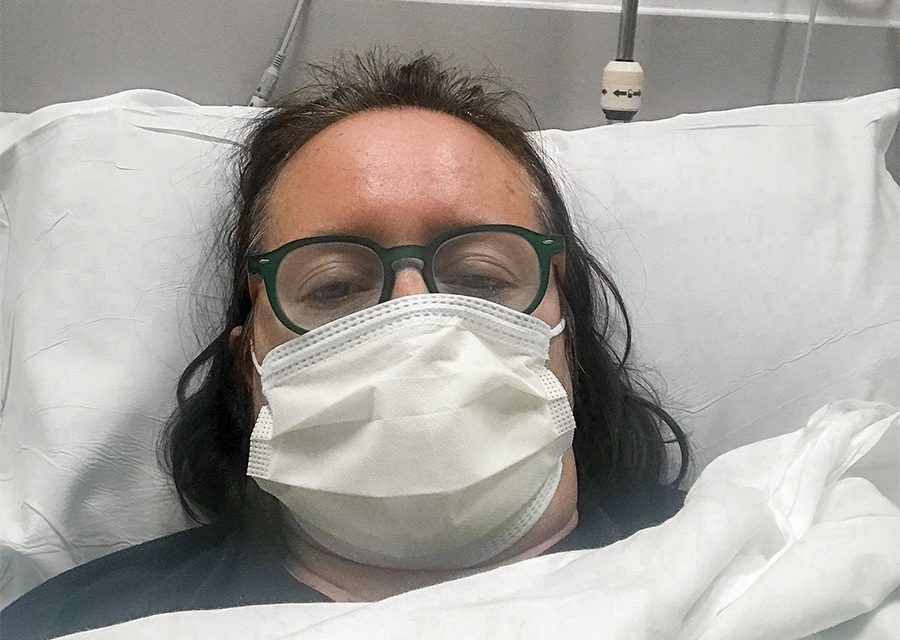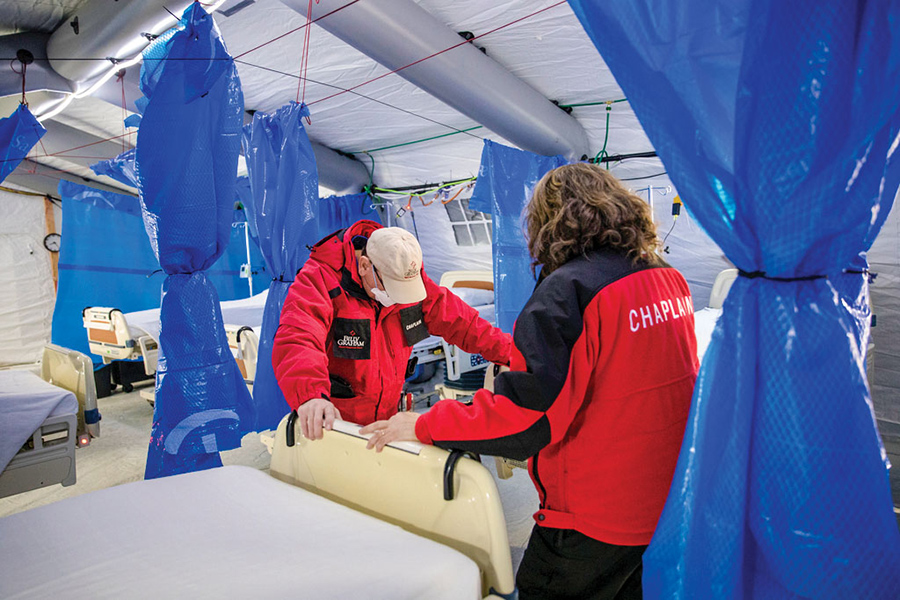My room was in a special wing of the hospital, separated from the other areas with a big “WARNING” sign taped to the door. When health care workers entered my room, they were so suited up with masks and gowns I could only see their eyes behind the visors.
I saw them infrequently. I was so contagious, and because the risk to the health care workers was so high, they came in only once every four hours or so in order to reduce their exposure.
When a nurse finally entered, I asked the same question I’d been asking ever since I’d arrived, “Have the test results come in yet?” Her eyes widened in shock. “No one has told you yet?” she replied, with a hint of frustration. I shook my head. “You are quite positive.” Although tears sprang to my eyes, I wasn’t surprised. I didn’t need a positive test or a nurse to tell me I had COVID-19. I knew it as soon as I began having symptoms four days earlier.
It started with a general malaise-y feeling: a headache, fever and body aches. My eyes stung and were red, and then I lost all sense of taste and smell. I had an insatiable thirst. I couldn’t even think about eating anything. My temperature got up to 102 degrees, and it felt like my blood was boiling. My husband had started to show symptoms as well, although not nearly as extreme as mine. Finally, after a day of frightening fainting spells, we knew it was time to go to the hospital. I was admitted and immediately quarantined. The doctors worked to stabilize me and concentrated on my dangerously low blood pressure. I was nervous but relieved to be in the hospital, so I was caught off guard the very next day when I learned I was being discharged. They told me they had stabilized me and that I had to continue to fight the virus at home. “The hospital is here to address life-threatening situations, and you’re out of the woods at this particular time,” a doctor explained.

But that night at home, my body erupted into a painful chaos of vomit, diarrhea and other symptoms so severe, I was sure it was going to be my last night on earth. The next day, back to the hospital we went. After another night’s stay, the doctor came to my room to announce that I was going home yet again. I pleaded with him to let me stay, knowing the tricky nature of this virus—you could feel better for a while, but then it would come roaring back. After he firmly refused my pleas, I asked what had been on my mind since the day I began showing symptoms: “What are my chances of survival?” He took a breath and spoke frankly. “About 50/50.”
How did I find myself in quarantine in a hospital with a chance of survival of only 50/50? Was my existence going to come down to a flip of the coin? Heads or tails?
I was fighting for my life, and it felt eerily familiar. I had been down this road before—almost 19 years earlier, on Sept. 11, 2001.
On that day, my husband, Brian, and I were on the balcony of our 24th floor apartment, six blocks from the World Trade Center. We were staring at the black smoke and destruction caused by the first plane, when out of nowhere the second plane came roaring overhead and struck the South Tower just 500 feet above us.
The impact hurled us backward into our living room and knocked us unconscious. When we came to, we grabbed our dog and evacuated our building. Barefoot and still wearing pajamas, we sought safety in nearby Battery Park. But the nightmare continued. The towers soon fell, covering us with toxic dust and debris, and heavy smoke surrounded us in a deadly cloud. We eventually managed to board a boat headed to New Jersey. We had escaped, but we couldn’t return to our apartment for months. We grappled with unemployment, PTSD and ongoing health issues, having inhaled the toxic dust that left us with “9/11 Lungs.”
I identified as a Christian then, but my faith was shallow, untested and compartmentalized. I was a sporadic Sunday churchgoer, and that was about the extent of my walk with the Lord. When the towers fell while we were in Battery Park, I asked Brian if he thought we were going to survive. He replied sadly, “Maybe not.” He grabbed my hands and began praying the Lord’s Prayer. Although I was happy that we were together during that awful time, I felt very alone.
It was then I realized that these might be my last moments on earth, and I didn’t know where I was going if I died. I became painfully aware that I didn’t possess a relationship with God, and that at age 32, I’d only ever lived for myself. It was a terrible acknowledgment that throughout my life there had been a Savior beckoning to me with open arms, and I’d never cared enough to respond.

Once we survived 9/11, I knew I was ready to explore a deeper connection with God. I never wanted to feel that alone again. We joined a church and experienced incredible spiritual growth through personal study, community groups and various church activities and outreach programs. As God became the center of our hearts, our lives went in a completely different direction. We now both work for the church, and our days are filled with ministry.
Nearly 20 years later, I lay in bed in my hospital room and prayed. “There is no 50/50 with You, Lord. You are Sovereign over this and if it’s in Your will, please heal me.”
I was very much alone in the room, but unlike in Battery Park, I never felt alone during my illness. I knew the Holy Spirit was with me. Having a deeper relationship with Christ gave me the courage to navigate the scary days of the virus in a way I could have never done on Sept. 11.
It took another few weeks of fighting the virus at home, but Brian and I both recovered.
In February, I joined the Samaritan’s Purse team that had been deployed to Lenoir, North Carolina, to help Caldwell Hospital with their COVID patients. From the moment I arrived, I was in awe at the level of care those patients received! The health care workers were constantly attending to them, and instead of a revolving door, patients stayed as long as they needed and wanted.
Instead of being sequestered alone as I had been in the hospital, Billy Graham Rapid Response Team chaplains spent every day praying for, crying with and counseling any patient who desired it. As I performed small tasks to assist in this incredible operation, I teared up at this wondrous display of God’s providence and mercy. I had weathered my COVID storm with God as my Rock and my Center, as opposed to suffering through the terror of 9/11 when He was not. And I had now been brought full circle to help others in their time of need. What a truly mighty God we serve! ©2021 Christina Stanton
Christina Stanton served as the director of missions at Redeemer Presbyterian Church in New York City for a decade. She is an award-winning author and a licensed NYC tour guide who specializes in 9/11 history. She and her husband founded a nonprofit organization, Loving all Nations, that helps the world’s poor. For more information, visit ChristinaRayStanton.com.
Photo: Aaron Milestone/AFP via Getty Images
